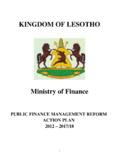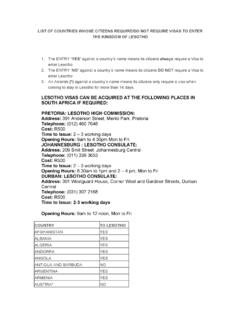Transcription of Lesotho Blood Policy Final 2 modified
1 1 Lesotho Blood TRANSFUSION SERVICES MINISTRY OF HEALTH AND SOCIAL WELFARE Lesotho NATIONAL Blood TRANSFUSION Policy 2006 2 TABLE OF CONTENTS i) List of ii) Executive 1 2 Aims and 3 4 Organization of National Blood Transfusion 1. The Minister of Health and Social Welfare ..10 2. National Blood Transfusion Committee (NBTC)..10 3. Lesotho Blood Transfusion Service (LBTS) ..12 4. Regional Blood Transfusion Centers (RBTCs) ..12 5. Responsibilities of RBTCs ..12 6. The Country Red Cross Society ..12 5 Principles of Blood Donation and 6 Code of Ethics for Blood 1. The donor and Blood donations ..14 2. Laboratory tests on donated 3. Blood preservation, transport and 4. The recipient and Blood transfusion ..16 5. Autologous transfusion.
2 17 7 Quality 8 9 Appendix I ..18 Appendix II ..18 Appendix III ..19 10 11 3 LIST OF ABBREVIATIONS 1. of Health and Social Welfare 2..National Blood Transfusion Committee 3. Blood Transfusion Service 4. Blood Transfusion Service 5. Lesotho Red Cross Society 6. Blood Transfusion center 7. Transmissible Infections 8. Immunodeficiency Virus 9. Immunodeficiency Syndrome 10. B surface Antigen 11. Health Assembly 12. Health Organization 13. Committee of Red Cross Societies 14. Society of Blood Transfusion 15. Assurance 16. NGOs ..Non Governmental Organizations 17. QE Elizabeth II hospital 18. Health Association of Lesotho 19. Linked Immuno-Sorbent Assay 4 EXECUTIVE SUMMARY This document is a Policy for the Blood Transfusion Services (BTS) in Lesotho .
3 It is a component of the Lesotho National Health Policy and it is in accordance with the Government effort to promote and facilitate safe Blood transfusion. This Policy is also in accordance with the standards and specifications of the WHO. The Policy is divided into eight chapters which are followed by relevant appendixes, a glossary and references. The Policy covers the significance of Blood transfusion in Health Care Delivery and also the associated risks of transmission of infectious agents such as HIV/AIDS and viral hepatitis. The Lesotho Blood Transfusion Service (LBTS) was created in June, 1984 as an integral part of the Central Laboratory Services by the Ministry of Health and Social Welfare. Its goal is to provide safe and adequate Blood and Blood products to all the hospitals in the country.
4 This is achieved through the recruitment, selection and retention of voluntary non-remunerated Blood donors, collection, processing, screening and storage of Blood and Blood products, distribution of Blood and Blood products to all the hospitals. Since 1987, Blood transfusion was centralized at the LBTS and all donated Blood screened for HIV, Hepatitis B and syphilis. The Policy describes the aims and objectives of the LBTS, strategies on how those objectives can be achieved. The document proposes a functional collaboration between LBTS and Lesotho Red Cross Society (LRCS), Non-governmental Organizations (NGOs) and the private sectors in issues pertaining to Blood donation and to form National Blood Transfusion Committee (NBTC) to enhance participation of other stakeholders.
5 The document describes the appointment and time frame of membership to the NBTC, functions and termination of membership. This document proposes the creation of a nationally coordinated organizational structure of the BTS by the MOHSW, separate from the Central Laboratory. LBTS, as the headquarters with adequate budget, qualified and trained staff, two Regional Blood Transfusion Centres (RBTC), one in the Northern Region and one in the Southern Region. The Policy defines the responsibilities of the RBTC and the LRCS. The principles of Blood donation and transfusion are defined and the Code of Ethics for Blood Transfusion pertaining to the donor and Blood donation, laboratory tests on donated Blood , preservation, storage, transportation and disposal of Blood and Blood products and the recipients and Blood transfusion are described.
6 5 The Policy emphasizes the need for quality assurance (QA) and a proper record keeping at the BTS, hospital laboratories and the wards for traceability of every unit from donation to transfusion or disposal. The reporting of any adverse reaction of Blood transfusion is proposed and the corrective measures to be taken. As soon as this Policy is approved, a detailed Plan of Action will be developed. 61. INTRODUCTION The administration of Blood can be life saving, and also improves health by alleviating illnesses and expediting recovery. Blood transfusion is therefore an essential part of health care delivery. However this vital therapeutic intervention may be associated with acute or delayed complications and carries the risk of transmission of infectious agents.
7 These transfusion transmissible infections (TTIs) include diseases of immense public health importance such as HIV/AIDS and viral hepatitis. In addition to these potential hazards the procedure requires both financial and human resources which are scarce especially in developing countries like Lesotho . Recognizing its significant role in health, and the fact that the hazards are preventable, the World Health Assembly (WHA) had passed Resolutions urging member states to enact effective legislative policies governing operations of Blood transfusion. The need for formulation and implementation of National Blood Transfusion Policies is also being repeatedly emphasized by The International Committee of Red Cross Societies (ICRCS), and the International Society of Blood Transfusion (ISBT).
8 This Policy is for the Kingdom of Lesotho and is in accordance with the standards and specifications of the World Health Organization (WHO), and is a component of the overall Lesotho National Health Policy . Situation Analysis The organization of Blood transfusion in Lesotho is loosely diffused in the Central Laboratory Service that supports patient care in hospitals, and there is no formal legislative instrument to guide their operations. There is no organized dedicated programme and the limited laboratory staff in the existing service are also hospital laboratory staff. The existing Blood bank is considered as a unit of the Central Laboratory on which it depends on administration, supervision and supplies. In 1984 a unit of the Central Laboratory was created and called Lesotho Blood Transfusion Services (LBTS), located at 23 Kingsway Street in Maseru, however donations were then hospital based.
9 Donation services became centralized in 1987 at the LBTS but up to date the LBTS has only three (3) dedicated staff called donor attendants who received only on the job local training on phlebotomy and keeping records. The other four laboratory technologists and one nursing sister who work in the LBTS are also staff of the Central Laboratory and Queen Elizabeth 11 (QE11) hospital respectively. The driver and the cleaners are also Central Laboratory staff. The current shortage of staff and the absence of an organized donor recruitment system results in the regular repeat donors forming only 5% of the Blood collections. 70% of the Blood is collected from Blood collecting campaigns in institutions all around the country, whilst 25-30% is collected at the LBTS.
10 Replacement/family donors form about 5%. About 20% of donors donating at the 7 LBTS are first time donors some of whom are interested in ascertaining their HIV status. The Blood collecting campaigns are not planned and are a response to low stocks in the Blood bank. Blood donation badges are given to regular donors according to the number of donations and a pen for 10th time donors. There has been a significant decline in the annual total donations in the past 10 years associated with a rise in the incidence of HIV in the population. In 1995 a total of 4178 units were collected while in 2003, 2700 units were donated representing about a 40% decline. The sentinel surveillance in 2003 showed an HIV prevalence of 29% in the general population and prevalence is noted among Blood donors.















